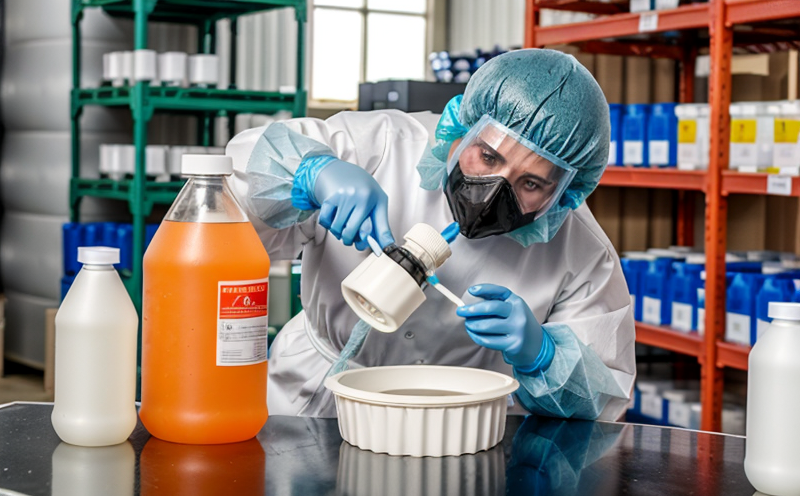WHO Microbiological Safety Testing of Packaging for Food and Pharma
In the pharmaceutical industry and food sector, ensuring the microbiological safety of packaging materials is paramount. Any breach in this safety can lead to product contamination, compromising both efficacy and patient health. World Health Organization (WHO) guidelines provide stringent standards that must be adhered to ensure compliance and product integrity.
The primary objective of WHO microbiological testing for packaging involves detecting microorganisms such as bacteria, fungi, and viruses within the packaging material itself or on its surface. This is particularly critical in ensuring that packaging does not introduce contaminants into food products during storage, transportation, or use. For pharmaceuticals, it ensures that the packaging does not affect drug stability or alter its efficacy.
The testing process involves a series of steps designed to mimic real-world conditions. Specimen preparation typically includes extracting samples from different parts of the packaging material under controlled environments. The extracted samples are then inoculated into appropriate media and incubated under optimal conditions that promote microbial growth. This step is crucial as it simulates how microorganisms might behave in actual use.
Identification of microorganisms follows standard microbiological techniques, including colony counting, Gram staining, and biochemical tests. Advanced molecular methods like polymerase chain reaction (PCR) are also employed for more specific identification of certain pathogens. The results help determine if the packaging meets WHO standards regarding microbial safety.
The importance of this testing cannot be overstated. It plays a vital role in preventing contamination that could lead to spoilage, recalls, and health issues. For pharmaceuticals, it ensures product integrity and patient safety. For food products, it maintains quality and consumer trust. Regulatory bodies worldwide, including WHO, emphasize the significance of such tests.
The testing process is not just about compliance but also about enhancing product reliability. It allows companies to identify potential risks early and implement corrective measures. This proactive approach ensures that only safe packaging reaches consumers, thereby upholding industry standards and public health protocols.
- Ensures Regulatory Compliance: Adherence to WHO guidelines is crucial for pharmaceuticals and food industries.
- Enhances Product Integrity: Safe packaging prevents contamination, maintaining product quality.
- Promotes Consumer Trust: Reliable packaging builds consumer confidence in brands.
- Reduces Risk of Contamination: Early detection minimizes the likelihood of serious health issues.
In conclusion, WHO microbiological safety testing for packaging materials is a cornerstone of ensuring product integrity and public health. It is an essential process that requires meticulous attention to detail and adherence to strict protocols. By implementing this testing, companies can ensure their products meet the highest standards of safety and quality.
Applied Standards
The microbiological safety testing for packaging in the food and pharmaceutical sectors must comply with stringent international standards. These include WHO guidelines alongside ISO 11697-3, which provides specific requirements for microbial limits on medical device packaging. For pharmaceuticals, compliance with USP is also critical.
In the context of food packaging, adherence to EU regulations such as Regulation (EC) No 2023/679 concerning hygiene conditions for food contact materials and articles is imperative. The regulation mandates rigorous testing protocols aimed at preventing contamination from packaging to ensure product safety.
For pharmaceuticals, the USP guidelines provide a framework for testing the microbiological quality of drug product containers. These standards are designed to ensure that the packaging does not introduce any harmful microorganisms into the medication. Similarly, the FDA's 21 CFR Part 820- Sterile Products provides detailed requirements on sterility assurance and microbial limits.
Adherence to these international standards ensures consistency in testing methodologies across different regions, thereby facilitating global trade. It also guarantees that products meet the highest safety and quality benchmarks set by regulatory bodies worldwide.
Scope and Methodology
The scope of microbiological safety testing for packaging materials encompasses a wide range of tests designed to assess various parameters that ensure the material's suitability for food and pharmaceutical use. This includes evaluating the physical properties, chemical composition, and microbial load of the packaging.
The methodology typically begins with specimen preparation. Samples are taken from different parts of the packaging material using sterile techniques to prevent contamination during sampling. These samples are then processed according to established protocols which may include extraction procedures tailored to specific materials like plastic, metal, or glass.
The extracted samples are inoculated into appropriate media and incubated under controlled conditions that promote optimal microbial growth. This step is critical as it simulates the real-world environment where microorganisms might thrive. The next phase involves identification of the microorganisms present using techniques such as colony counting, Gram staining, and biochemical tests.
Advanced molecular methods like PCR are also employed for more precise identification of certain pathogens. For instance, PCR can be used to detect specific DNA sequences associated with harmful bacteria or viruses. These results provide a comprehensive picture of the microbial content within the packaging material.
The final step involves analyzing and interpreting these test results against WHO guidelines and other relevant standards. This analysis helps determine whether the packaging meets the required safety criteria. If any non-compliance is detected, corrective actions are implemented to ensure future batches meet all standards.





